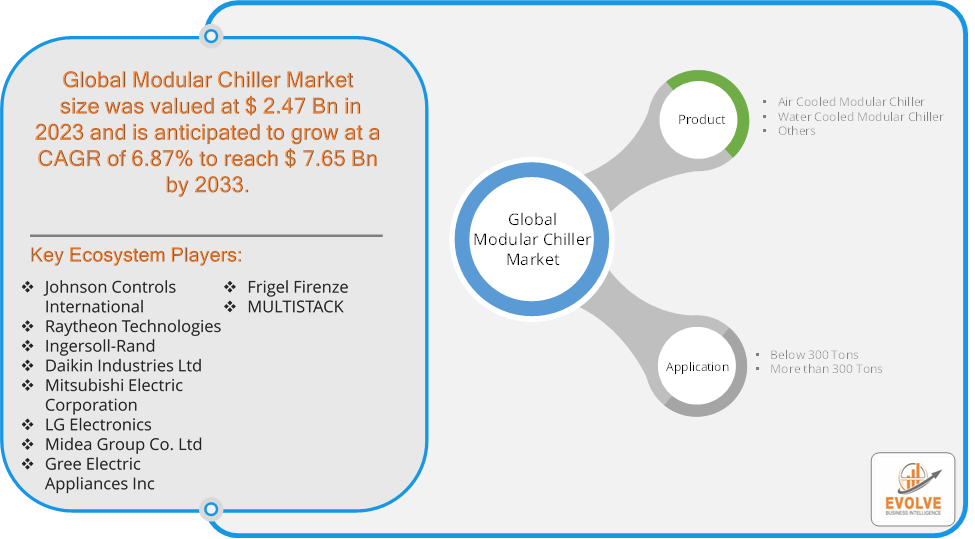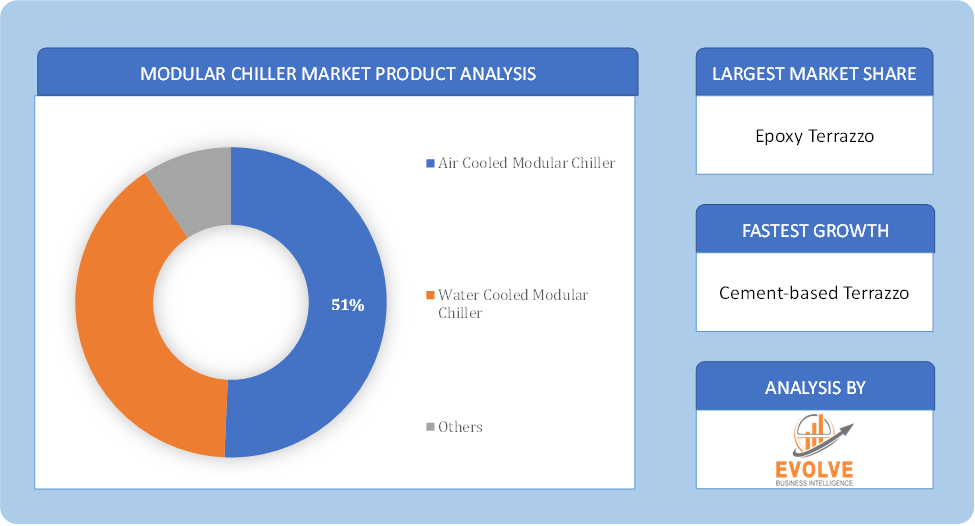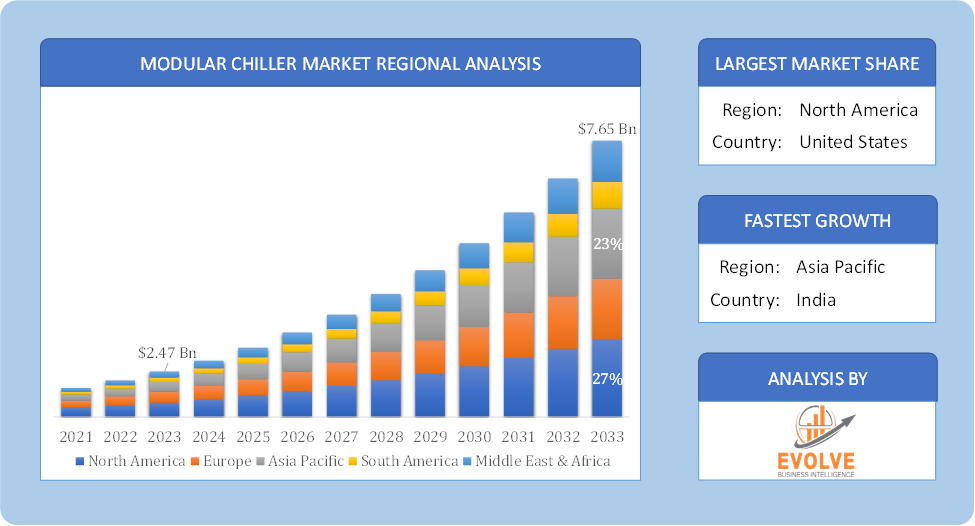Modular Chiller Market Analysis and Global Forecast 2023-2033
$ 1,390.00 – $ 5,520.00Price range: $ 1,390.00 through $ 5,520.00
Modular Chiller Market Research Report: Information By Product Type (Air Cooled Modular Chiller, Water Cooled Modular Chiller), By Capacity (Below 300 Tons, More than 300 Tons), and by Region — Forecast till 2033
Page: 165
Modular Chiller Market Overview
The Modular Chiller Market Size is expected to reach USD 7.65 Billion by 2033. The Modular Chiller industry size accounted for USD 2.47 Billion in 2023 and is expected to expand at a compound annual growth rate (CAGR) of 6.87% from 2023 to 2033. The modular chiller market involves the production and distribution of modular chillers, which are scalable cooling systems designed for various applications, including commercial, industrial, and institutional settings. These chillers are composed of multiple, independent units that can be added or removed to adjust cooling capacity, offering flexibility and energy efficiency. They are favored for their ease of installation, maintenance, and ability to provide redundancy and reliability in HVAC systems. The market is driven by increasing demand for energy-efficient cooling solutions, technological advancements, and growing construction activities globally. Key players in this market focus on innovation and expanding their product portfolios to meet diverse customer needs.
Global Modular Chiller Market Synopsis
 COVID-19 Impact Analysis
COVID-19 Impact Analysis
The COVID-19 pandemic has led to supply chain disruptions leading to supply shortages or lower demand in the modular chiller market. The travel restrictions and social-distancing measures have resulted in a sharp drop in consumer and business spending and this pattern is to continue for some time. The end-user trend and preferences have changed due to the pandemic and have resulted in manufacturers, developers, and service providers adopting various strategies to stabilize the company.
Modular Chiller Market Dynamics
The major factors that have impacted the growth of Modular Chiller are as follows:
Drivers:
Ø Technological Advancements
Advances in chiller technology, including improved compressor designs, heat exchangers, and control systems, contribute to the market’s growth. These innovations enhance performance, reliability, and operational efficiency of modular chillers, making them more attractive to end-users seeking cutting-edge HVAC solutions.
Restraint:
- High Initial Costs
One of the primary challenges for modular chillers is their relatively high initial costs compared to traditional HVAC systems. While modular chillers offer long-term operational savings through energy efficiency and scalability, the upfront investment can be prohibitive for some buyers, especially in cost-sensitive markets or for smaller-scale projects.
Opportunity:
⮚ Renovation and Retrofit Projects
The need to upgrade existing HVAC systems in older buildings presents a significant market opportunity. Modular chillers offer advantages in retrofit projects due to their modular design, which facilitates easier installation in constrained spaces and reduces disruption to ongoing operations.
Modular Chiller Segment Overview
 By Product
By Product
Based on Product, the market is segmented based on Air Cooled Modular Chiller, Water Cooled Modular Chiller, Product 3, Product 4 the “Air Cooled Modular Chiller” segment typically dominates. This is driven by its versatility, lower installation costs, and suitability for applications where water availability or quality is a concern, such as in urban areas or regions with limited water resources.
By Capacity
Based on Capacitys, the market has been divided into the Below 300 Tons, More than 300 Tons. the “Below 300 Tons” segment tends to dominate. This is primarily due to its suitability for a wide range of commercial and institutional applications, where smaller to mid-sized cooling capacities are sufficient and cost-effective compared to larger systems.
Global Modular Chiller Market Regional Analysis
Based on region, the global Modular Chiller market has been divided into North America, Europe, Asia-Pacific, the Middle East & Africa, and Latin America. North America is projected to dominate the use of the Modular Chiller market followed by the Asia-Pacific and Europe regions.
 Modular Chiller North America Market
Modular Chiller North America Market
North America holds a dominant position in the Modular Chiller Market. North America’s modular chiller market is robust, driven by stringent energy efficiency regulations and a strong focus on sustainable building practices. The region benefits from a mature construction sector and high adoption rates of advanced HVAC technologies. Key factors contributing to market growth include increasing investments in commercial and industrial infrastructure, particularly in sectors like healthcare, IT, and data centers, which require reliable and efficient cooling solutions. The market is also influenced by technological advancements, such as smart controls and variable speed compressors, aimed at optimizing energy usage and operational costs. Moreover, government incentives for energy-efficient HVAC systems further encourage adoption of modular chillers across the continent.
Modular Chiller Asia-Pacific Market
The Asia-Pacific region has indeed emerged as the fastest-growing market for the Modular Chiller industry. The Asia-Pacific modular chiller market is experiencing rapid growth driven by urbanization, industrialization, and increasing construction activities across emerging economies. Countries like China, India, and Southeast Asian nations are witnessing significant infrastructure development, which fuels demand for efficient HVAC solutions including modular chillers. The region’s market growth is also supported by rising awareness of energy efficiency and environmental sustainability, prompting industries and commercial sectors to adopt advanced cooling technologies. Technological innovations in modular chiller design, such as integration with smart building systems and renewable energy sources, are further enhancing market attractiveness. Government initiatives promoting energy-efficient building practices and sustainable development policies are additional drivers accelerating market expansion in Asia-Pacific.
Competitive Landscape
The global Modular Chiller market is highly competitive, with numerous players offering a wide range of software solutions. The competitive landscape is characterized by the presence of established companies, as well as emerging startups and niche players. To increase their market position and attract a wide consumer base, the businesses are employing various strategies, such as product launches, and strategic alliances.
Prominent Players:
- Johnson Controls International
- Raytheon Technologies
- Ingersoll-Rand
- Daikin Industries Ltd
- Mitsubishi Electric Corporation
- LG Electronics
- Midea Group Co. Ltd
- Gree Electric Appliances Inc
- Frigel Firenze
- MULTISTACK
Key Development
In September 2022, Daikin Industries Ltd., a key player in the modular chiller market, focused on enhancing its product portfolio with advanced energy-efficient technologies and expanding its market presence through strategic partnerships and acquisitions.
Scope of the Report
Global Modular Chiller Market, by Product
- Air Cooled Modular Chiller
- Water Cooled Modular Chiller
- Others
Global Modular Chiller Market, by Application
- Below 300 Tons
- More than 300 Tons
Global Modular Chiller Market, by Region
- North America
- US
- Canada
- Mexico
- Europe
- UK
- Germany
- France
- Italy
- Spain
- Benelux
- Nordic
- Rest of Europe
- Asia Pacific
- China
- Japan
- South Korea
- Indonesia
- Austalia
- Malaysia
- India
- Rest of Asia Pacific
- South America
- Brazil
- Argentina
- Rest of South America
- Middle East & Africa
- Saudi Arabia
- UAE
- Egypt
- South Africa
- Rest of Middle East & Africa
| Parameters | Indicators |
|---|---|
| Market Size | 2033: USD 7.65 Billion |
| CAGR (2023-2033) | 6.87% |
| Base year | 2022 |
| Forecast Period | 2023-2033 |
| Historical Data | 2021 (2017 to 2020 On Demand) |
| Report Coverage | Revenue Forecast, Competitive Landscape, Growth Factors, and Trends |
| Key Segmentations | Product Type, Capacity |
| Geographies Covered | North America, Europe, Asia-Pacific, South America, Middle East, Africa |
| Key Vendors | Johnson Controls International, Raytheon Technologies, Ingersoll-Rand, Daikin Industries Ltd, Mitsubishi Electric Corporation, LG Electronics, Midea Group Co. Ltd, Gree Electric Appliances Inc, Frigel Firenze, MULTISTACK. |
| Key Market Opportunities | · The rise of e-commerce |
| Key Market Drivers | · Technological Advancements · Increasing Urbanization |
REPORT CONTENT BRIEF:
- High-level analysis of the current and future Modular Chiller market trends and opportunities
- Detailed analysis of current market drivers, restraining factors, and opportunities in the future
- Modular Chiller market historical market size for the year 2021, and forecast from 2023 to 2033
- Modular Chiller market share analysis at each product level
- Competitor analysis with detailed insight into its product segment, Government & Defense strength, and strategies adopted.
- Identifies key strategies adopted including product launches and developments, mergers and acquisitions, joint ventures, collaborations, and partnerships as well as funding taken and investment done, among others.
- To identify and understand the various factors involved in the global Modular Chiller market affected by the pandemic
- To provide a detailed insight into the major companies operating in the market. The profiling will include the Government & Defense health of the company’s past 2-3 years with segmental and regional revenue breakup, product offering, recent developments, SWOT analysis, and key strategies.
Frequently Asked Questions (FAQ)
What is the study period of this market?
The study period of the global Modular Chiller market is 2021- 2033
What is the growth rate of the global Modular Chiller market?
The global Modular Chiller market is growing at a CAGR of 6.87% over the next 10 years
Which region has the highest growth rate in the market of Modular Chiller?
Asia Pacific is expected to register the highest CAGR during 2023-2033
Which region has the largest share of the global Modular Chiller market?
North America holds the largest share in 2022
Who are the key players in the global Modular Chiller market?
Johnson Controls International, Raytheon Technologies, Ingersoll-Rand, Daikin Industries Ltd, Mitsubishi Electric Corporation, LG Electronics, Midea Group Co. Ltd, Gree Electric Appliances Inc, Frigel Firenze, and MULTISTACK are the major companies operating in the market.
Do you offer Post Sale Support?
Yes, we offer 16 hours of analyst support to solve the queries
Do you sell particular sections of a report?
Yes, we provide regional as well as country-level reports. Other than this we also provide a sectional report. Please get in contact with our sales representatives.
Press Release

Global Pharmaceutical Manufacturing Market to Reach $1.38 Trillion by 2035 with 7.35% CAGR, New Research Shows

The Global Mammography Market Is Estimated To Record a CAGR of Around 10.29% During The Forecast Period

Glue Stick Market to Reach USD 2.35 Billion by 2034

Podiatry Service Market to Reach USD 11.88 Billion by 2034

Microfluidics Technology Market to Reach USD 32.58 Billion by 2034

Ferric Chloride Market to Reach USD 10.65 Billion by 2034

Family Practice EMR Software Market to Reach USD 21.52 Billion by 2034

Electric Hairbrush Market to Reach USD 15.95 Billion by 2034

Daily Bamboo Products Market to Reach USD 143.52 Billion by 2034

Cross-border E-commerce Logistics Market to Reach USD 112.65 Billion by 2034
Table of Content
Chapter 1. Executive Summary Chapter 2. Scope Of The Study 2.1. Market Definition 2.2. Scope Of The Study 2.2.1. Objectives of Report 2.2.2. Limitations 2.3. Market Structure Chapter 3. Evolve BI Methodology Chapter 4. Market Insights and Trends 4.1. Supply/ Value Chain Analysis 4.1.1. Raw Capacitys Providers 4.1.2. Manufacturing Process 4.1.3. Distributors/Retailers 4.1.4. End-Use Industry 4.2. Porter’s Five Forces Analysis 4.2.1. Threat Of New Entrants 4.2.2. Bargaining Power Of Buyers 4.2.3. Bargaining Power Of Suppliers 4.2.4. Threat Of Substitutes 4.2.5. Industry Rivalry 4.3. Impact Of COVID-19 on the Modular Chiller Market 4.3.1. Impact on Market Size 4.3.2. End-Use Industry Trend, Preferences, and Budget Impact 4.3.3. Regulatory Framework/Government Policies 4.3.4. Key Players' Strategy to Tackle Negative Impact 4.3.5. Opportunity Window 4.4. Technology Overview 12.28. Macro factor 4.6. Micro Factor 4.7. Demand Supply Gap Analysis of the Modular Chiller Market 4.8. Import Analysis of the Modular Chiller Market 4.9. Export Analysis of the Modular Chiller Market Chapter 5. Market Dynamics 5.1. Introduction 5.2. DROC Analysis 5.2.1. Drivers 5.2.2. Restraints 5.2.3. Opportunities 5.2.4. Challenges 5.3. Patent Analysis 5.4. Industry Roadmap 5.5. Parent/Peer Market Analysis Chapter 6. Global Modular Chiller Market, By Product Type 6.1. Introduction 6.2. Air Cooled Modular Chiller 6.3. Water Cooled Modular Chiller 6.4. Others Chapter 7. Global Modular Chiller Market, By Capacity 7.1. Introduction 7.2. Below 300 Tons 7.3. More than 300 Tons Chapter 8. Global Modular Chiller Market, By Region 8.1. Introduction 8.2. North America 8.2.1. Introduction 8.2.2. Driving Factors, Opportunity Analyzed, and Key Trends 8.2.3. Market Size and Forecast, By Country, 2023-2033 8.2.4. Market Size and Forecast, By Product Type, 2023-2033 8.2.5. Market Size and Forecast, By Capacity, 2023-2033 8.2.6. US 8.2.6.1. Introduction 8.2.6.2. Driving Factors, Opportunity Analyzed, and Key Trends 8.2.6.3. Market Size and Forecast, By Product Type, 2023-2033 8.2.6.4. Market Size and Forecast, By Capacity, 2023-2033 8.2.7. Canada 8.2.7.1. Introduction 8.2.7.2. Driving Factors, Opportunity Analyzed, and Key Trends 8.2.7.4. Market Size and Forecast, By Product Type, 2023-2033 8.2.7.5. Market Size and Forecast, By Capacity, 2023-2033 8.3. Europe 8.3.1. Introduction 8.3.2. Driving Factors, Opportunity Analyzed, and Key Trends 8.3.3. Market Size and Forecast, By Country, 2023-2033 8.3.4. Market Size and Forecast, By Product Type, 2023-2033 8.3.5. Market Size and Forecast, By Capacity, 2023-2033 8.3.6. Germany 8.3.6.1. Introduction 8.3.6.2. Driving Factors, Opportunity Analyzed, and Key Trends 8.3.6.3. Market Size and Forecast, By Product Type, 2023-2033 8.3.6.4. Market Size and Forecast, By Capacity, 2023-2033 8.3.7. France 8.3.7.1. Introduction 8.3.7.2. Driving Factors, Opportunity Analyzed, and Key Trends 8.3.7.3. Market Size and Forecast, By Product Type, 2023-2033 8.3.7.4. Market Size and Forecast, By Capacity, 2023-2033 8.3.8. UK 8.3.8.1. Introduction 8.3.8.2. Driving Factors, Opportunity Analyzed, and Key Trends 8.3.8.3. Market Size and Forecast, By Product Type, 2023-2033 8.3.8.4. Market Size and Forecast, By Capacity, 2023-2033 8.3.9. Italy 8.3.9.1. Introduction 8.3.9.2. Driving Factors, Opportunity Analyzed, and Key Trends 8.3.9.3. Market Size and Forecast, By Product Type, 2023-2033 8.3.9.4. Market Size and Forecast, By Capacity, 2023-2033 8.3.11. Rest Of Europe 8.3.11.1. Introduction 8.3.11.2. Driving Factors, Opportunity Analyzed, and Key Trends 8.3.11.3. Market Size and Forecast, By Product Type, 2023-2033 8.3.11.4. Market Size and Forecast, By Capacity, 2023-2033 8.4. Asia-Pacific 8.4.1. Introduction 8.4.2. Driving Factors, Opportunity Analyzed, and Key Trends 8.4.3. Market Size and Forecast, By Country, 2023-2033 8.4.4. Market Size and Forecast, By Product Type, 2023-2033 8.12.28. Market Size and Forecast, By Capacity, 2023-2033 8.4.6. China 8.4.6.1. Introduction 8.4.6.2. Driving Factors, Opportunity Analyzed, and Key Trends 8.4.6.3. Market Size and Forecast, By Product Type, 2023-2033 8.4.6.4. Market Size and Forecast, By Capacity, 2023-2033 8.4.7. India 8.4.7.1. Introduction 8.4.7.2. Driving Factors, Opportunity Analyzed, and Key Trends 8.4.7.3. Market Size and Forecast, By Product Type, 2023-2033 8.4.7.4. Market Size and Forecast, By Capacity, 2023-2033 8.4.8. Japan 8.4.8.1. Introduction 8.4.8.2. Driving Factors, Opportunity Analyzed, and Key Trends 8.4.8.3. Market Size and Forecast, By Product Type, 2023-2033 8.4.8.4. Market Size and Forecast, By Capacity, 2023-2033 8.4.9. South Korea 8.4.9.1. Introduction 8.4.9.2. Driving Factors, Opportunity Analyzed, and Key Trends 8.4.9.3. Market Size and Forecast, By Product Type, 2023-2033 8.4.9.4. Market Size and Forecast, By Capacity, 2023-2033 8.4.10. Rest Of Asia-Pacific 8.4.10.1. Introduction 8.4.10.2. Driving Factors, Opportunity Analyzed, and Key Trends 8.4.10.3. Market Size and Forecast, By Product Type, 2023-2033 8.4.10.4. Market Size and Forecast, By Capacity, 2023-2033 8.5. Rest Of The World (RoW) 8.5.1. Introduction 8.5.2. Driving Factors, Opportunity Analyzed, and Key Trends 8.5.3. Market Size and Forecast, By Product Type, 2023-2033 8.5.4. Market Size and Forecast, By Capacity, 2023-2033 Chapter 9. Company Landscape 9.1. Introduction 9.2. Vendor Share Analysis 9.3. Key Development Analysis 9.4. Competitor Dashboard Chapter 10. Company Profiles 10.1. Johnson Controls International 10.1.1. Business Overview 10.1.2. Government & Defense Analysis 10.1.2.1. Government & Defense – Existing/Funding 10.1.3. Product Portfolio 10.1.4. Recent Development and Strategies Adopted 10.1.5. SWOT Analysis 10.2. Raytheon Technologies 10.2.1. Business Overview 10.2.2. Government & Defense Analysis 10.2.2.1. Government & Defense – Existing/Funding 10.2.3. Product Portfolio 10.2.4. Recent Development and Strategies Adopted 10.2.5. SWOT Analysis 10.3. Ingersoll-Rand 10.3.1. Business Overview 10.3.2. Government & Defense Analysis 10.3.2.1. Government & Defense – Existing/Funding 10.3.3. Product Portfolio 10.3.4. Recent Development and Strategies Adopted 10.3.5. SWOT Analysis 10.4. Daikin Industries Ltd 10.4.1. Business Overview 10.4.2. Government & Defense Analysis 10.4.2.1. Government & Defense – Existing/Funding 10.4.3. Product Portfolio 10.4.4. Recent Development and Strategies Adopted 10.12.28. SWOT Analysis 10.5. Mitsubishi Electric Corporation 10.5.1. Business Overview 10.5.2. Government & Defense Analysis 10.5.2.1. Government & Defense – Existing/Funding 10.5.3. Product Portfolio 10.5.4. Recent Development and Strategies Adopted 10.5.5. SWOT Analysis 10.6. LG Electronics 10.6.1. Business Overview 10.6.2. Government & Defense Analysis 10.6.2.1. Government & Defense – Existing/Funding 10.6.3. Product Portfolio 10.6.4. Recent Development and Strategies Adopted 10.6.5. SWOT Analysis 10.7. Midea Group Co. Ltd 10.7.1. Business Overview 10.7.2. Government & Defense Analysis 10.7.2.1. Government & Defense – Existing/Funding 10.7.3. Product Portfolio 10.7.4. Recent Development and Strategies Adopted 10.7.5. SWOT Analysis 10.8 Gree Electric Appliances Inc 10.8.1. Business Overview 10.8.2. Government & Defense Analysis 10.8.2.1. Government & Defense – Existing/Funding 10.8.3. Product Portfolio 10.8.4. Recent Development and Strategies Adopted 10.8.5. SWOT Analysis 10.9 Frigel Firenze 10.9.1. Business Overview 10.9.2. Government & Defense Analysis 10.9.2.1. Government & Defense – Existing/Funding 10.9.3. Product Portfolio 10.9.4. Recent Development and Strategies Adopted 10.9.5. SWOT Analysis 10.10. MULTISTACK 10.10.1. Business Overview 10.10.2. Government & Defense Analysis 10.10.2.1. Government & Defense – Existing/Funding 10.10.3. Product Portfolio 10.10.4. Recent Development and Strategies Adopted 10.10.5. SWOT Analysis
Connect to Analyst
Research Methodology



 Modular Chiller North America Market
Modular Chiller North America Market

